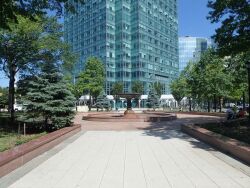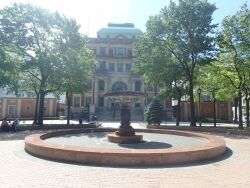Court Square Park
Court Square Park
This park stands directly in front of the Queens County Court House in Long Island City. On October 22, 1872, the City of New York purchased the land on which the courthouse and Court Square Park stand. The first Long Island City courthouse, built two years later, was designed in the French Second Empire style by John Hathorne. In 1904, however, a worker repairing the roof accidentally set it ablaze, destroying the entire building. To replace the old courthouse, architect Peter Coco designed a neo-English Renaissance building, which opened in 1908. Ironically, Coco was indicted on corruption charges a year later, and was tried and convicted in the very courthouse he designed.
In 1932, the city began construction on the east and west wings of the Long Island City Court House, and purchased the land on which these wings stand in 1934. Because of labor strikes and other delays, eight years passed before the building reopened. In the interim, court sessions were held at the Masonic temple on Jackson Avenue.
In 1934, the land that is now Court Square Park was divided into two separate plots. On August 10, 1938, a local law named the northeast section of the land Court Square, and in 1951, another local law named the southwest section of the land Albert E. Short Square.
Albert E. Short (1874-1951), a Long Island City native, received his law degree from Fordham University in 1929 and served as a Queens Assistant District Attorney from 1938 to 1951. He developed a reputation for prosecuting “rackets” cases—prosecutions against those allegedly involved in bootlegging or extortion. Short was in charge of the District Attorney’s Youth Program and was interested in the problem of juvenile delinquency and its correction. In 1942, he served as the Exalted Ruler of the Queensboro Lodge of Elks, a local branch of a hierarchical fraternal society. Short died on March 3, 1951 and local legislators felt that “the name of a man who devoted himself to the problems of our youth should be perpetuated by naming this square in Queens in his memory.”
In the early 1990s, the city decided to merge Short Square and Court Square and build a small park at the intersection of Jackson Avenue, Thompson Avenue, and Court Square, directly in front of the courthouse. The 1951 local law that named Short Square was rescinded, and the entire parcel of land was named Court Square Park. The legacy of Albert E. Short, however, is perpetuated by the name of nearby Short Triangle.
Several lampposts and tall birch trees stand around the beautiful fountain in Court Square Park. There are benches and intertwined walkways that lead up to the entrance of the magnificent courthouse.
Check out your park's Vital Signs
Clean & Safe
Green & Resilient
Empowered & Engaged Users
Share your feedback or learn more about how this park is part of a
Vital Park System




